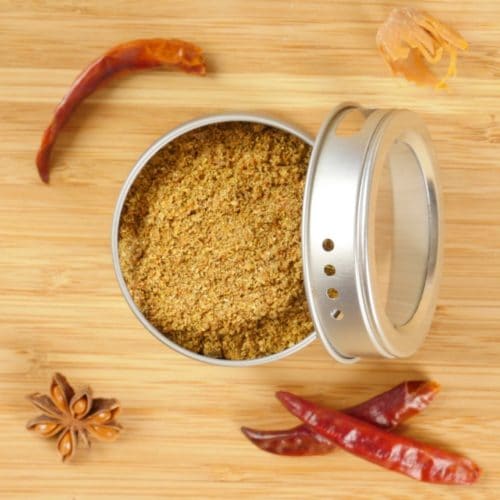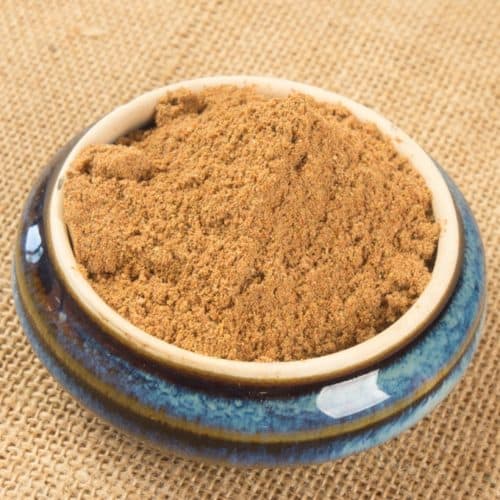
Warming Spices
Of all the spice blends most frequently used in Indian cooking, garam masala powder is IT. The word garam means warm, and masala is a mixture of spices. It is often used at the very end of cooking, just before serving to add an aromatic warmth and depth. I have now tracked down a dozen different garam masalas, and I am sure there are more. Some are specific to the type of ingredients being cooked like poultry, vegetables, seafood, and red meat.
Other variations are for the kind of dish such as biryani, and yet others are blends are by region, the most common being the North Indian Punjabi masala using coriander, cumin, cloves, cardamom, black pepper, cinnamon, and bay leaves. I am of the school that garam masala is not meant to add heat to your cooking; that is done with additional chilies you add as you cook.
Regional Variations
Raghavan Iyer, in his book “660 Curries,” which I highly recommend, catalogs seven garam masalas. Some recipes require you to toast the spices whole before grinding, and others do not. Besides the Punjabi garam masala, from the western state of Maharashtra—with its coastal influences— add coconut, peanuts, and sesame seeds. Swinging way up to Kashmir, cooks use fennel, ground ginger, nutmeg, and mace. Chef Iyer's favorite choice for a grocery store curry blend is called bin bhuna hua garam masala. This is a simple coriander-scented masala with a dried red chili kick.
Another Maharashtrian blend comes from Kolhapur, an artist community that contributes to the garam masala world with bold, chili forward flavors. Their blend has mace, mustard seeds, and fenugreek seeds. And lastly, Chef Iyer’s favorite is a Pakistani blend called Balti garam masala, which is especially popular in England and is perfumed with a good measure of cloves.
For my regional variations make my Kerala garam masala scented with fennel and star anise, and my chili-forward Goan garam masala.
Make it Your Own
As with all cooking, the exact blend and proportions vary from cook to cook, often handed down from their mothers, and each one is sure that their blend is the very best. The following recipe is primarily based on the Punjabi Garam Masala published in “660 Curries,” though I have doubled the recipe and added herbaceous, sweet fennel seeds and some green cardamom for some floral, citrus notes.
Buy
If you prefer not to make your own garam masala powder, I can recommend the following brands: Rani, MTR, Shaan, Badshah (found in Indian grocery stores and online), Penzey's, The Spice House, Sprouts, and Trader Joe's.
I have also posted recipes for a Kerala garam masala and a Goan garam masala if you would like to make these spice mixes.
Happy cooking!
~ Alonna
See the Notes below before you cook.
Recipe Card 📖
Garam Masala Powder
Ingrediants
- 2 tablespoons coriander seeds
- 2 teaspoons cumin seeds
- 2 teaspoons whole cloves
- 1 tablespoon fennel seeds
- 1 teaspoon black peppercorns
- 1 tablespoon black cardamom pods
- 1 tablespoon green cardamom pods
- 3 3-inch cassia sticks
- 3 bay leaves ~ Indian bay leaves if you have them
- 1 tablespoons dried rose petals ~ Optional
- 1/2 star anise ~ Optional
Instructions
- In a mortar and pestle or using a heavy pan, crush the black cardamom pods so you can remove the seeds. The green cardamom can be toasted and ground with the shell on.
- In a large pan over medium heat, toast all the spices except for the rose petals and star anise, if using. Shake the pan frequently for about a minute or two keep the spices from burning. You are looking for the spices to become highly aromatic and start to turn a slightly darker shade.
- Pour the spices out onto a plate and cool completely. Adding in the rose petals and star anise, if using, process the spices into a fine powder in a spice grinder in batches, depending on the size of your spice grinder. I like to sieve the spices and if there are any larger pieces, run them through the grinder again. Use immediately, or store in an airtight container.
Notes
- Shortcut: buy garam masala powder, if you don’t have time to make your own. I like the garam masala blend from Penzeys, and Indian groceries carry Indian made blends that are quite popular. My favorite is the Rani brand.
- Use cassia instead of true cinnamon if you have it. Cassia is the variety of cinnamon most often used in India.
- Roasting whole spices make them easier to grind and brings out the individual flavors.
- Do not be tempted to increase the heat in order to speed up the process, or you will end up with a bitter flavor that will spoil your dish.
- Most garam masala mixes are not intended to add heat to your cooking. Each recipe you are making will have fresh green chilies and/or whole or ground red chilies as needed.








Leave a Reply